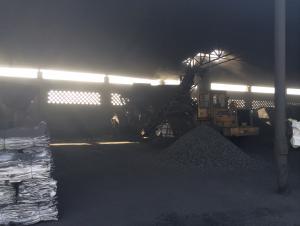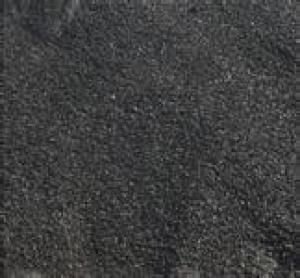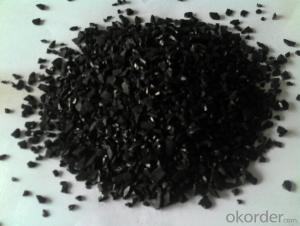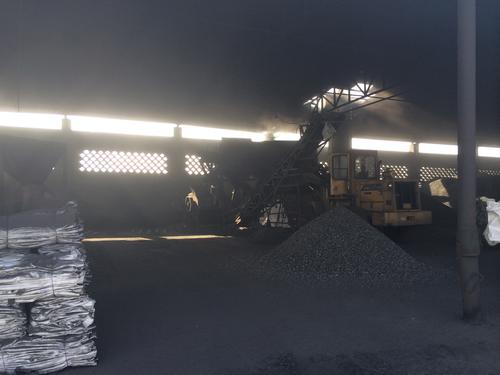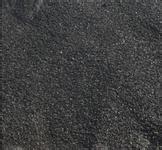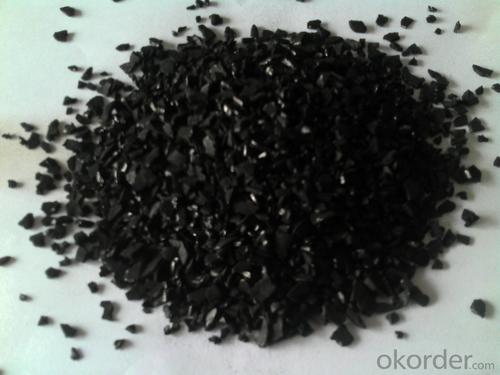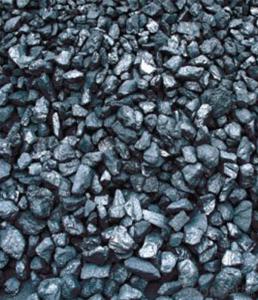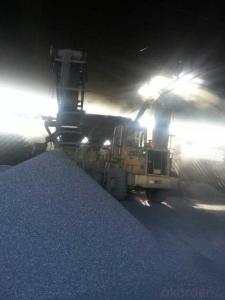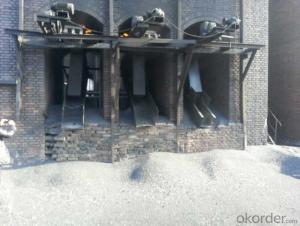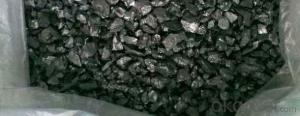90%Carbon Content 1-2,2-4mm Calcined Anthracite
- Loading Port:
- Tianjin
- Payment Terms:
- TT OR LC
- Min Order Qty:
- 1 m.t.
- Supply Capability:
- 10000000 m.t./month
OKorder Service Pledge
OKorder Financial Service
You Might Also Like
1.Structure of Calcined Anthracite Description
This product is made from high-quality anthracite as raw materials, shape of columnar respectively, particles, powder, such as spherical shape, has high strength, adsorption speed, adsorption capacity, high specific surface area is larger, developed pore structure, pore size is between coconut shell activated carbon and wood charcoal.
Mainly used for high-end air purification, waste gas treatment, waste incineration, high pure water treatment, wastewater treatment, wastewater treatment, aquatic animals, desulphurization and denitration, and can effectively remove the impurities and contaminants in the gas and liquid as well as a variety of gas separation and purification, also can be widely used in all kinds of low boiling point substances adsorption recycling, deodorization oil removal, etc.
2.Main Features of the Calcined Anthracite
Calcined Anthracite is a kind of filter used in water treatment. It is suitable for the treatment of common acid, the middle degree alkali. This product has large surface area, and its various indexes all exceed the Construction Department’s standard. Anthracite filter is especially selected from the deep well minerals, so it includes the highest percentage of carbo. It must have been filtered and washed to make sure it can be used for water filting. Since it has better granular maintaining ability, so it can improve the floating granular’s cleaning ability.
3. Calcined Anthracite Images

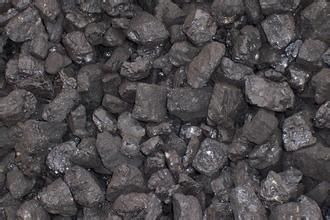
4. Calcined Anthracite Specification
| Place of Origin: | Shanghai, China (Mainland) | Brand Name: | CNBM | Model Number: | xy29 |
| Usage: | Paper Chemicals,Petroleum Additives | Model: | Water treatment anthracite filter media | Moisture: | 1% |
| hardness: | 90% | PH: | 9 | Ash Content (%): | 4% |
| Dimensions: | 1-3mm,3-5mm,5-8mm | Application: | Application | Volatile: | 1.5% |
| other name: | calcined anthracite |
5.FAQ of Calcined Anthracite
1). Q: Are you a factory or trading company?
A: We are a factory.
2). Q: Where is your factory located? How can I visit there?
A: Our factory is located in ShanXi, HeNan, China. You are warmly welcomed to visit us!
3). Q: How can I get some samples?
A: Please connect me for samples
4). Q: Can the price be cheaper?
A: Of course, you will be offered a good discount for big amount.
- Q: How does carbon form?speed
- How is coal formed?Coal is known as black gold, the food industry, it is one of the main energy use of the human world since eighteenth Century. Although its important position has been replaced by oil, but in the future for a long period of time, due to the exhaustion of petroleum, inevitable decline, but because of the huge reserves of coal, and the rapid development of science and technology, the new technology of coal gasification is becoming more mature and widely used, coal will become one of the production and life of human beings in an irreplaceable energy.Coal is millions of years of plant leaves and roots, stacked on the ground with a layer of very thick black humus, due to changes in the earth's crust constantly buried underground, long isolated from the air and under high temperature and pressure, after a series of complex physical and chemical changes and other factors, the formation of black however, this fossil, is the coal forming process.The thickness of coal seam in a coal mine and the crust drop speed and accumulation amount of plant remains. The crust decreased rapidly, the plant remains piled thick, the coal seam is thick, on the other hand, the crust decline slowly, the accumulation of plant remains thin, the mine coal seam is thin. The tectonic movement of the crust to the original level of coal seam folds and faults occur, some underground coal seam buried deeper, and squeezed to the surface, even above the ground, more likely to be found. There are some relatively thin coal seam, and the area is not large, so there is no value related to the formation of coal mining, so far not find the update statement.
- Q: What are the consequences of increased carbon emissions on economic stability?
- Increased carbon emissions have significant consequences on economic stability. Firstly, the costs associated with climate change impacts such as extreme weather events, rising sea levels, and damage to infrastructure can burden economies, leading to increased expenditures for adaptation and recovery. Additionally, carbon-intensive industries may face regulatory measures and higher costs, impacting their competitiveness and potentially leading to job losses. The need for transitioning to cleaner energy sources and implementing carbon pricing mechanisms can also entail upfront investments and adjustment costs for businesses. Finally, the potential disruption of global supply chains due to climate-related events can disrupt trade and negatively impact economic stability. Overall, increased carbon emissions pose risks to economic stability by exacerbating climate change impacts and necessitating costly adjustments.
- Q: What is carbon nanotechnology?
- The study and engineering of materials at the nanoscale using carbon-based materials, such as carbon nanotubes and graphene, is known as carbon nanotechnology. This branch of science focuses on manipulating and examining materials at a scale of 1 to 100 nanometers. Carbon nanotechnology takes advantage of carbon's distinctive properties to create and control nanostructures with exceptional mechanical, electrical, and chemical attributes. For instance, carbon nanotubes are cylindrical structures composed of carbon atoms arranged in a hexagonal lattice. Their unique structure grants them remarkable strength, thermal conductivity, and electrical properties. Consequently, carbon nanotubes have a wide range of potential applications in electronics, energy storage, and materials science. They offer the promise of creating stronger and lighter materials, more efficient batteries, and faster and smaller electronic devices. Another carbon-based material, graphene, is a single layer of carbon atoms arranged in a hexagonal lattice. It possesses exceptional strength, electrical conductivity, and thermal conductivity. Graphene has the potential to revolutionize industries such as electronics, medicine, and energy. Its properties make it an ideal candidate for flexible electronics, high-performance batteries, and even drug delivery systems. The development of methods to synthesize and manipulate carbon-based nanostructures is an essential aspect of carbon nanotechnology. Researchers employ techniques like chemical vapor deposition, laser ablation, and molecular self-assembly to create nanoscale carbon materials. These techniques allow for precise control over the size, shape, and properties of the nanostructures, enabling the design of materials with tailored properties for specific applications. In conclusion, carbon nanotechnology explores the unique properties and applications of carbon-based materials at the nanoscale. It has the potential to revolutionize various industries and create new technologies that can bring numerous benefits to society.
- Q: How does carbon contribute to air pollution?
- Carbon contributes to air pollution primarily through the combustion of fossil fuels. When carbon-based fuels such as coal, oil, and natural gas are burned for energy, they release carbon dioxide (CO2) into the atmosphere, which is a greenhouse gas that contributes to global warming and climate change. Additionally, incomplete combustion of these fuels can produce other pollutants such as carbon monoxide (CO), volatile organic compounds (VOCs), and particulate matter, which all have detrimental effects on air quality and human health.
- Q: How does carbon affect the formation of earthquakes?
- Carbon does not directly affect the formation of earthquakes. Earthquakes are primarily caused by the movement of tectonic plates, which are large sections of the Earth's crust that float on the semi-fluid layer below. These plates can collide, slide past each other, or move apart, causing stress to build up along the plate boundaries. When the stress becomes too great, it is released in the form of an earthquake. However, carbon can indirectly impact the occurrence of earthquakes through its role in the Earth's carbon cycle and its contribution to climate change. Carbon dioxide (CO2) is a greenhouse gas that is released into the atmosphere through various human activities, such as burning fossil fuels. This excess CO2 in the atmosphere leads to global warming and climate change. Climate change can have several effects on the Earth's crust, some of which may indirectly influence seismic activity. For example, the melting of glaciers and polar ice caps due to global warming can lead to changes in the distribution of mass on the Earth's surface. This redistribution of mass can cause the Earth's crust to adjust, leading to increased stress along fault lines and potentially triggering earthquakes. Additionally, changes in precipitation patterns and the hydrological cycle caused by climate change can affect groundwater levels and pore pressure within rocks. These changes in water content can alter the strength and stability of fault lines, potentially making them more prone to slipping and causing earthquakes. It is important to note that the direct impact of carbon on earthquake formation is minimal compared to the primary factors such as plate tectonics. However, the relationship between carbon emissions, climate change, and seismic activity is an area of ongoing research and scientific investigation.
- Q: How is carbon used in the production of batteries?
- Carbon is an essential component in the production of batteries due to its unique properties. It is commonly used as an electrode material in both primary (non-rechargeable) and secondary (rechargeable) batteries. In primary batteries, carbon is used as a cathode material. It acts as a host for the chemical reactions that occur during the discharge process, enabling the flow of electrons. Carbon's high conductivity is crucial in ensuring efficient electron transfer, allowing the battery to deliver power effectively. Additionally, carbon's stability and low reactivity make it an ideal material for long-lasting primary batteries. In secondary batteries, such as lithium-ion batteries, carbon is utilized in both the anode and cathode. The anode consists of graphite, a form of carbon that can intercalate lithium ions during charging and release them during discharging. This process allows for the reversible storage and release of energy, making graphite an excellent choice for the anode material. Carbon is also used in the cathode of secondary batteries, where it enhances the overall performance. Carbon-based materials, like carbon black, are added to the cathode to improve its electrical conductivity and increase the surface area available for reactions. This leads to higher energy and power densities, improving the battery's overall performance. Furthermore, carbon additives, such as carbon nanotubes or graphene, are being explored to enhance battery performance further. These carbon-based materials have unique properties like high surface area, high electrical conductivity, and mechanical strength, which can potentially improve the energy storage capacity and lifespan of batteries. In summary, carbon plays a vital role in battery production by enabling efficient electron transfer, storage, and release of energy. Its conductivity, stability, and ability to intercalate ions make it an essential component in both primary and secondary batteries, contributing to the advancement of energy storage technology.
- Q: What are the impacts of carbon emissions on the stability of estuaries?
- Estuaries, delicate and unique ecosystems where freshwater and saltwater mix, are significantly impacted by carbon emissions. One of the main consequences is ocean acidification, which occurs when carbon dioxide from human activities like burning fossil fuels is absorbed by the ocean, increasing the water's acidity. This heightened acidity has detrimental effects on estuary stability. Estuaries are home to a diverse array of marine life, including fish, shellfish, and plants. However, the increased acidity disrupts the delicate balance of these ecosystems. Many shellfish species, like oysters and clams, rely on calcium carbonate to build their shells and skeletons. In more acidic waters, the availability of carbonate ions decreases, making it challenging for these organisms to form and maintain their protective structures. Consequently, shellfish populations decline, impacting the entire estuarine food chain. Moreover, increased acidity affects the reproductive processes of many marine organisms. Fish and other species that reproduce in estuaries may experience reduced reproductive success due to changes in water pH. This decline in population numbers leads to a loss of biodiversity within estuaries. Furthermore, rising sea levels caused by carbon emissions also impact estuary stability. As global temperatures increase, glaciers and ice caps melt, causing the sea level to rise. Estuaries, often situated in low-lying coastal areas, are particularly vulnerable. Rising sea levels can increase salinity levels in estuaries as saltwater intrudes further into freshwater areas. This disruption in the delicate balance affects the survival of plants and animals dependent on specific salinity levels. In conclusion, carbon emissions have various negative impacts on estuary stability. Ocean acidification disrupts the delicate balance, affecting the reproduction and survival of species. Rising sea levels caused by carbon emissions further destabilize estuaries by altering salinity levels. To protect and preserve these valuable ecosystems, it is crucial to reduce carbon emissions and mitigate the effects of climate change.
- Q: How does carbon affect the water cycle?
- Carbon affects the water cycle in several ways. Firstly, carbon plays a crucial role in the atmosphere, where it exists in the form of carbon dioxide (CO2). The concentration of CO2 in the atmosphere has been increasing due to human activities such as burning fossil fuels, deforestation, and industrial processes. This increase in carbon dioxide levels leads to global warming and climate change, which in turn affects the water cycle. One major impact of increased carbon dioxide is the alteration of precipitation patterns. Warmer temperatures caused by carbon emissions can lead to more evaporation from bodies of water, resulting in increased water vapor in the atmosphere. This extra moisture can then lead to more intense rainfall in some areas, causing floods, while other regions may experience droughts as evaporation rates exceed precipitation rates. These changes in precipitation patterns disrupt the balance of the water cycle, affecting the availability of water resources for both human and natural systems. Furthermore, carbon dioxide dissolved in water forms carbonic acid, which lowers the pH level of oceans and bodies of water, a process known as ocean acidification. This acidification can negatively impact marine life, including shellfish, corals, and other organisms that rely on calcium carbonate to build their shells or skeletons. As a result, the disruption of these species can have cascading effects through the food chain, ultimately impacting the entire ecosystem. Carbon also influences the melting of polar ice caps and glaciers. Rising global temperatures caused by increased carbon emissions accelerate the melting process. As the ice melts, it releases freshwater into the oceans, leading to a rise in sea levels. This rise in sea levels can have devastating consequences for coastal communities, increasing the risk of flooding and erosion. In summary, carbon emissions, primarily in the form of carbon dioxide, have a significant impact on the water cycle. They alter precipitation patterns, contribute to ocean acidification, and accelerate the melting of ice, all of which disrupt the delicate balance of the water cycle and have far-reaching consequences for ecosystems and communities around the world.
- Q: How to match?Want to breed a batch of roses seedlings, but the seedbed of mud, carbon soil do not know how to get, there is help in this regard...
- Five: sowing, that is, sowing and breeding in spring. Can also be seeding and furrow sowing, usually in mid April to germination. Spring planting and transplanting time autumn planting two, usually in late autumn or early spring before the leaves after the sap flow. Grafting grafting used multiflora rootstock, grafting and grafting of two points. Autumn budding survival rate, grafting position close to the ground as far as possible, the specific method is: in the side branch with rootstock grafting knife on the skin do "T" shaped incision, and then rose from the year growth of branches in a good selection of bud. Insert the bud into the "T" incision, then tie it with a plastic bag and shade properly so that it will heal in about two weeks. Plant ramets breeding more in late autumn or early spring, is the whole rose out of ramets soil, each plant has 1 to 2 branches and with some fibrous roots, the colonization in the basin or open, then can blossom. Cutting method in late autumn or early spring rose dormancy, their mature with 3 to 4 shoots cuttings. If the shoots are cut, shade properly and keep the seedbed moist. After cutting, the root can take root in 30 days, and the survival rate is from 70% to 80%. If the cuttings are dipped in the root, the survival rate will be higher. Layerage general in the summer, is the rose from parent branches bent down and pressed into soil, buried in the central branches, the lower half circle of the bark off, exposing branch end, the branches grow adventitious roots and grow new leaves, and then cut off the mother. As for the preparation of nutritious peat soil according to the following formula: two (1) mixture of peat mire soil and vermiculite, the proportion (by dry weight) for each 1/2 or 3/5:1/4; 2/5 or 3/4:1/4, then add the right amount of limestone (dolomite) and sandy fertilizer. (2) peat swamp soil 25-50%, vermiculite 0-25%, plus 50% of the soil. All of the above materials have been bought in the flower market.
- Q: How does carbon impact the migration patterns of animals?
- Carbon emissions from human activities contribute to climate change, which in turn affects the migration patterns of animals. Rising temperatures, altered precipitation patterns, and changing habitats disrupt the availability of food, water, and suitable nesting or breeding grounds for many species. As a result, some animals may alter their migration routes, timing, or destinations, while others may struggle to adapt and face population declines or even extinction. The impact of carbon on animal migration underscores the urgent need to mitigate greenhouse gas emissions and protect the ecosystems that support these vital movements.
Send your message to us
90%Carbon Content 1-2,2-4mm Calcined Anthracite
- Loading Port:
- Tianjin
- Payment Terms:
- TT OR LC
- Min Order Qty:
- 1 m.t.
- Supply Capability:
- 10000000 m.t./month
OKorder Service Pledge
OKorder Financial Service
Similar products
Hot products
Hot Searches
